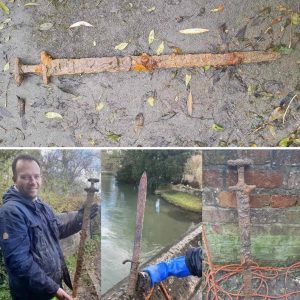One of the most extraordinary archaeological discoveries of recent times was the uncovering of the so-called Seahenge off the north coast of Norfolk, United Kingdom.
The enigmatic 4,000-year-old structure discovered in 1998 was a groundbreaking moment in Bronze Age archaeology. Preserved in the shifting sands of Holme beach on the North Norfolk coast, the unique timber circle named Seahenge resembled Stonehenge in Wiltshire.

Seahenge. Credit: Explore Norfolk
“The circle was originally built on the saltmarsh away from the sea, and specialists estimate it to have been built of timbers dating from the spring of 2049 BC.
It would have been positioned in an area protected from the sea by sand dunes and mud flats. This swampy area created a layer of peat which slowly covered the timbers, protecting them from decay
The circle is 6.6m in diameter and comprises of 55 closely-fitted oak posts originally standing up to 3m in height.
It is thought to have been constructed by the people of the small farming communities who lived in wattle and daub round houses.”
According to Francis Pryor and his wife, an ancient woodworking and analysis expert, Seahenge demonstrates how much Western civilization owes to the prehistoric societies in Europe in the last four millennia BC.
Pryor was convinced ‘Seahenge’ “was never at sea. The timbers were constructed on dry land.”

Seahenge (Holme I) in the temporary exhibition “The World of Stonehenge” at the British Museum. Credit: JvL – CC BY 2.0
Holme beach was a salt marsh and not a sandy beach 4,000 years ago.
Gradually, over 3000-4000 years, the sea has encroached the land and covered the peat beds which were naturally preserving the timbers.”
Why Did Seahenge Become A Controversy?Archaeologists who examined Seahenge understood the ancient site’s significance, and the site “has been firmly in the public’s eye since its controversial “rescue excavation” in 1999. The remains of the site, threatened by coastal erosion, were removed from their original location with the intention of preservation and conservation at another location.” 4
“Once removed the timbers were taken to the Bronze Age Centre at Flag Fen, near Peterborough, and were placed in fresh water tanks to clean the mud and salts. After experts had examined and studied them, a complex conservation project was started. In 2008, half of the timbers and, two years later, the central stump were put on permanent display in Lynn Museum.” 1
To save Seahenge, removing the tree stumps before they deteriorated was necessary. However, moving the tree stumps was controversial, and many objected on environmental or religious grounds.
“Some objectors were completely oblivious to the damage that the sea could cause to the timbers, which was one of the reasons for moving it.
Others, the druids, objected on religious grounds.
Other groups felt it would bring the tourists to Norfolk if it was left on the beach and didn’t want it disturbed. Norfolk is a county rich in history, and this would have been another great feather in its cap.
The Norfolk Wildlife Trust were opposed to the timber circle remaining on the beach because it lay on the edge of the Holme Dunes Nature Reserve and they knew that crowds of people visiting the site would cause great disturbance to the feeding waders and other wildlife.”
Today, the Lynn Museum has the original upturned tree stump and some of the original timbers, and they have also made a life-size timber semi-circle Seahenge replica.
How Did Ancient People Use Seahenge?The purpose of Seahenge has never been determined, but there are speculations, of course.
One theory states that the upturned tree stumps were put there so dead bodies could be laid on top and birds and animals could pick away the flesh and bones.
“Whether or not the roots of the inverted tree ever held a corpse, I don’t know. But something did seem to be missing. The tree was the focal point of the entire monument, yet it was empty. Maybe that was the effect the builders of the monument intended. We can’t tell.
We now know that the site was constructed in a short time. I would go so far as to suggest that it represents a single event, and I am also confident that once the event was over, the circle ceased to retain its special ‘magic.’ I don’t think this site was revisited subsequently.
A final important point: I don’t believe that the particular spot on what is today Holme beach was especially important in the Bronze Age. I suspect it was chosen because the group who built the circle controlled or had access to that area within the larger ritual landscape, and the precise spot was selected because it may have been slightly higher than the ground round about. Maybe there was some other reason – perhaps the presence of an oak seedling or a gull’s nest. We can only guess,” Francis Pryor writes in his book Seahenge: A Quest For Life And Death In Bronze Age Britain.
The purpose of Seahenge is still a mystery. What cannot be denied, though, is that it remains an incredible monument to the skill and beliefs of our Bronze Age ancestors.





